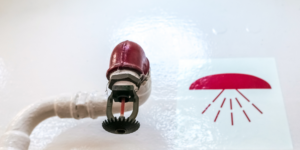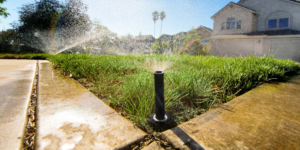Fireproofing homes and properties using sprinkler systems is essential. Did you know sprinklers vary? Each sprinkler type has its own benefits and features. Standard, residential, and quick-response sprinklers will be compared. We’ll discuss their benefits and downsides to help you choose one for your home.
What is a Standard Sprinkler?
What is a typical sprinkler? It’s the most typical commercial and industrial sprinkler system. When fire temperatures rise, these sprinklers activate. A small glass bulb filled with heat-sensitive liquid expands and shatters when heated.
The sprinkler head releases water to extinguish flames once the bulb breaks. Sprinklers with larger droplets and lesser pressure are called standard sprinklers.
A major benefit of conventional sprinklers is reliability. They have suppressed fires for years after rigorous testing. Due to their wider spray patterns, they can cover more ground.
However, conventional sprinklers may respond slower than others. This delay could accelerate fire development before activation.
Standard sprinklers are frequently used due to their affordability and effectiveness in controlling fires in many locations, despite this shortcoming.
What is a Residential Sprinkler?
Residential sprinklers are designed to prevent fires in homes. Residential sprinklers are designed for homes and flats, unlike commercial sprinklers.
Since they demand less water pressure, these sprinklers flow less. This makes it easy to connect to existing plumbing systems without major changes. Commercial sprinklers have larger spray patterns and cover more space than residential ones.
Residential sprinklers have aesthetic charm. Manufacturers know homeowners want their fire safety systems to match their decor. Thus, many residential sprinkler models have diverse finishes and styles to match home decor.
Quick response times are another benefit of these sprinklers. Residential sprinklers activate quickly to put out fires caused by heat or smoke. This early reaction reduces property damage and gives inhabitants more time to flee safely.

What is a Quick Response Sprinkler?
A quick reaction sprinkler responds swiftly to fires. Quick-response sprinklers are designed to activate at lower temperatures than household sprinklers.
In places that need rapid fire suppression, these sprinklers are used. They are found in commercial, industrial, healthcare, hotel, and high-rise buildings.
Fast reaction time is an important aspect of a quick-response sprinkler. This sprinkler head detects heat faster than others due to its smaller thermal element. The heat from a close fire activates these sprinklers, which spray water instantaneously.
Over other systems, quick-response sprinklers have many advantages. First and foremost, their swift fire suppression can reduce property damage and save lives. They operate with less water pressure than residential models.
However, choosing quick-response sprinklers for your home or structure requires some considerations. Due of their design and components, these systems may cost more than domestic ones. Only fire prevention system designers should install them.
Pros and Cons of each type of sprinkler
Pros of standard sprinklers: Most commercial structures use standard sprinklers. Their simplistic design makes installation and maintenance affordable. These sprinklers cover a big area efficiently with a regular pattern.
Standard sprinklers take longer to activate than others. The delay could cause more fire damage before the sprinklers activate. Because they release water across a broader area, furniture, and equipment may be damaged.
The benefits of residential sprinklers include being built for use in homes and smaller settings. Their tiny design matches your home’s beauty. They also activate faster than traditional sprinklers.
Residential sprinklers cost more than regular ones, which is their biggest drawback. However, their efficiency at preventing fire spreads may make this expenditure beneficial for homeowners protecting their property and loved ones.
Pros of Quick Response Sprinklers: Quick response sprinklers activate faster than residential or standard types. These systems use heads that react quickly to fire and smoke.
Cons: Quick response sprinkler systems protect against flames spreading quickly, but kitchen smells or shower/laundry room steam can activate them accidentally.
Your property’s needs determine the pros and downsides of each sprinkler type. Before choosing a type, engage professionals who can evaluate your space.
Which type of sprinkler is best for your home?
What sprinkler is best for your home? Choosing the correct sprinkler system for your home involves several criteria. Standard, residential, and quick-response sprinklers have different benefits.
Standard sprinklers are found in commercial and industrial structures. Larger orifices allow higher water flow rates. They are suitable for high ceilings or hazards that demand more water coverage.
Residence sprinklers are meant for homes and small structures. They feature a narrower aperture than ordinary sprinklers, reducing water flow. Fire prevention and property water damage are minimized by these sprinklers.
Quick-response sprinklers are like residential ones but respond faster. They activate quickly when heated and assist in fighting fires early. In areas where fire suppression is urgent, quick-response sprinklers are suitable.
The appropriate sprinkler system for your home depends on its size, ceiling height, occupancy classification, and local building standards. You should consult a fire protection engineer to determine your demands and recommend the best choice.
No matter the type, appropriate installation is essential. Your system should be installed by a qualified technician following all laws.
Finally… Oops! I almost summarized! Choose the proper sprinkling based on your needs—don’t rush!

How to install a sprinkler system
Installing a sprinkler system can be challenging but with the appropriate instructions and rewarding DIY endeavors. Check your local building regulations and get permits before starting.
Plan your sprinkler system arrangement first. Measure your yard and mark sprinkler head locations. Consider water pressure and coverage area while spacing heads.
Dig sprinkler head pipe trenches next. Use a shovel or trenching instrument to dig channels deep enough for pipes to sit without exposure.
PVC pipes go in after trenches are dug. Join them with primer and cement as per the manufacturer’s instructions. Secure all connections before continuing.
After installing the main lines, place and install each sprinkler head. If necessary, secure them for risers or swing joints.
Test each irrigation zone after connecting it to water. Optimal coverage may require adjustments.
This is simply a basic overview of sprinkler system installation; refer to manufacturer guides for complete instructions pertaining to your system.
Conclusion
Choosing the correct sprinkler system for your home might affect your safety and peace of mind. Knowing the distinctions between conventional, residential, and quick-response sprinklers helps you choose.
Standard sprinklers are reliable and affordable for commercial and high-ceilinged structures. They provide enough coverage and respond to heat above a certain degree.
Residential sprinklers have the same benefits as regular sprinklers but are built for homes. They control fires and blend into residential settings while being smaller and more attractive.
However, quick-response sprinklers respond faster to heat, providing better protection. They fight flames faster than home sprinklers because they activate at lower temperatures.
Each sprinkler has perks and cons. For large settings that prioritize cost, standard sprinklers may be better. In situations where rapid fire suppression is needed, quick-response sprinklers may be better than residential sprinklers for homes and small structures.
Your property’s size, occupancy classification, and local building standards will determine the ideal sprinkler system. Contact a fire prevention engineer before making any selections to get the best system for your property.
